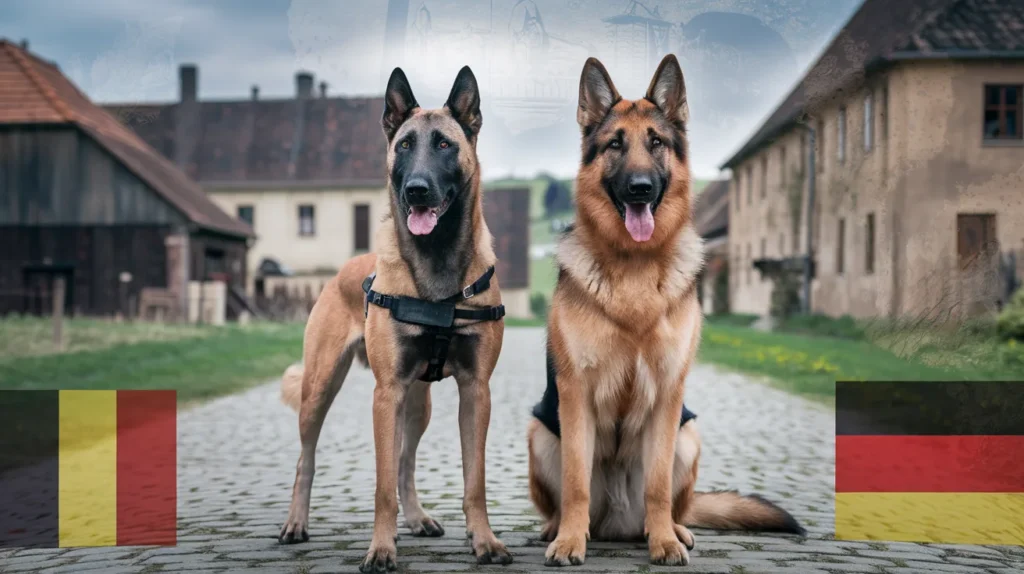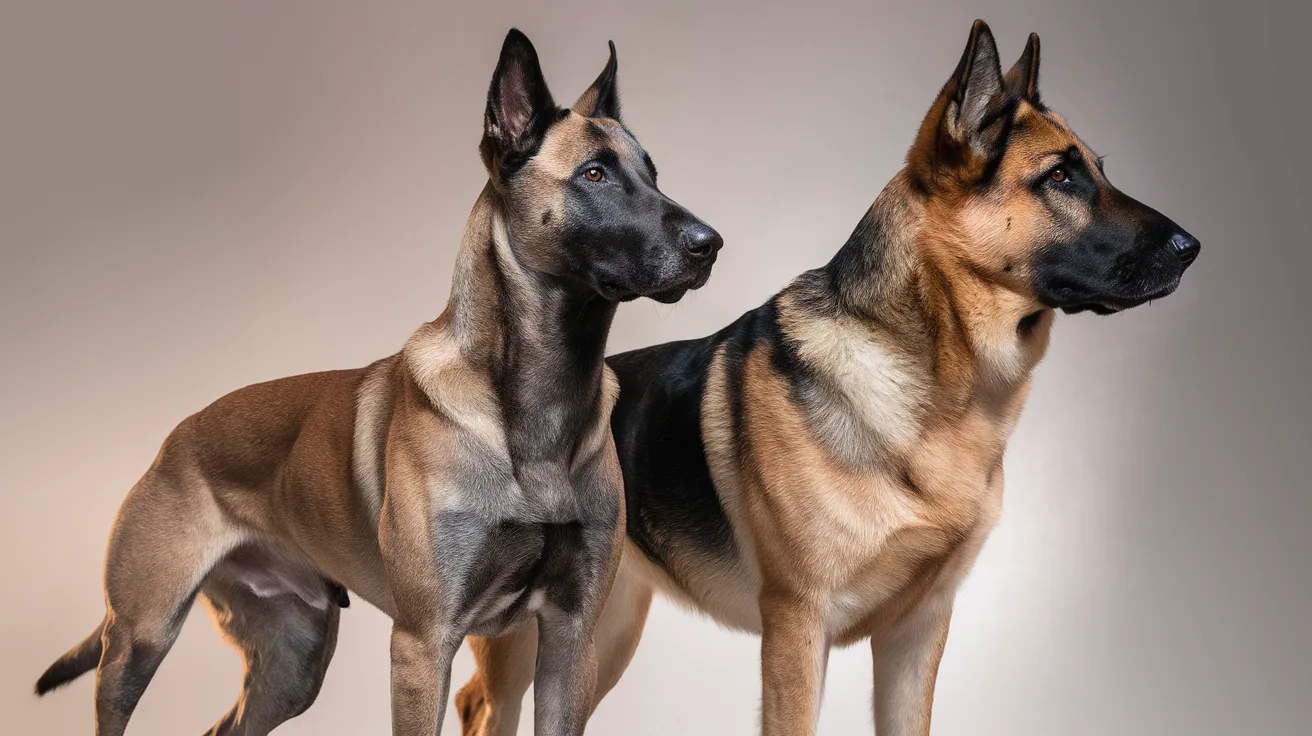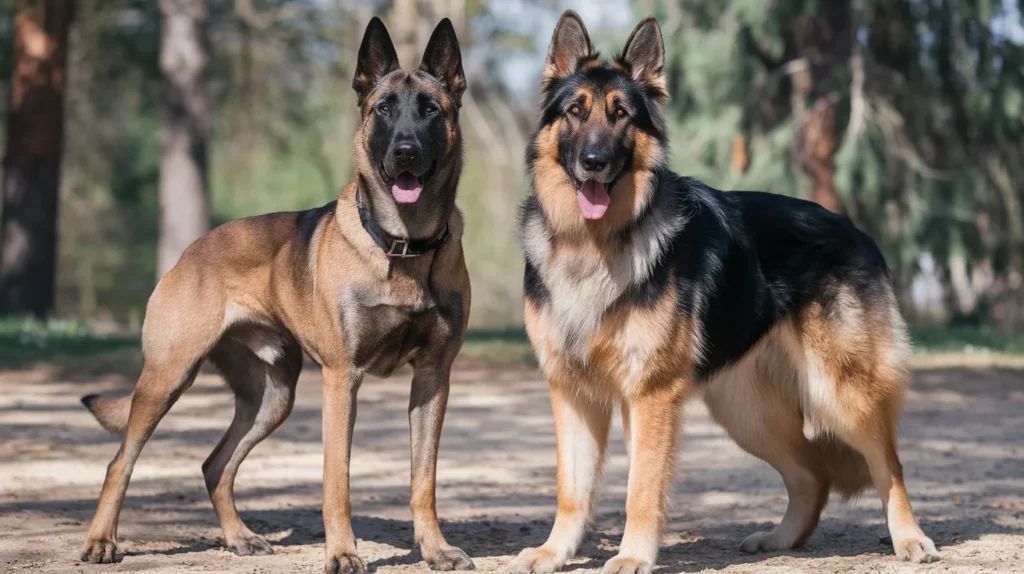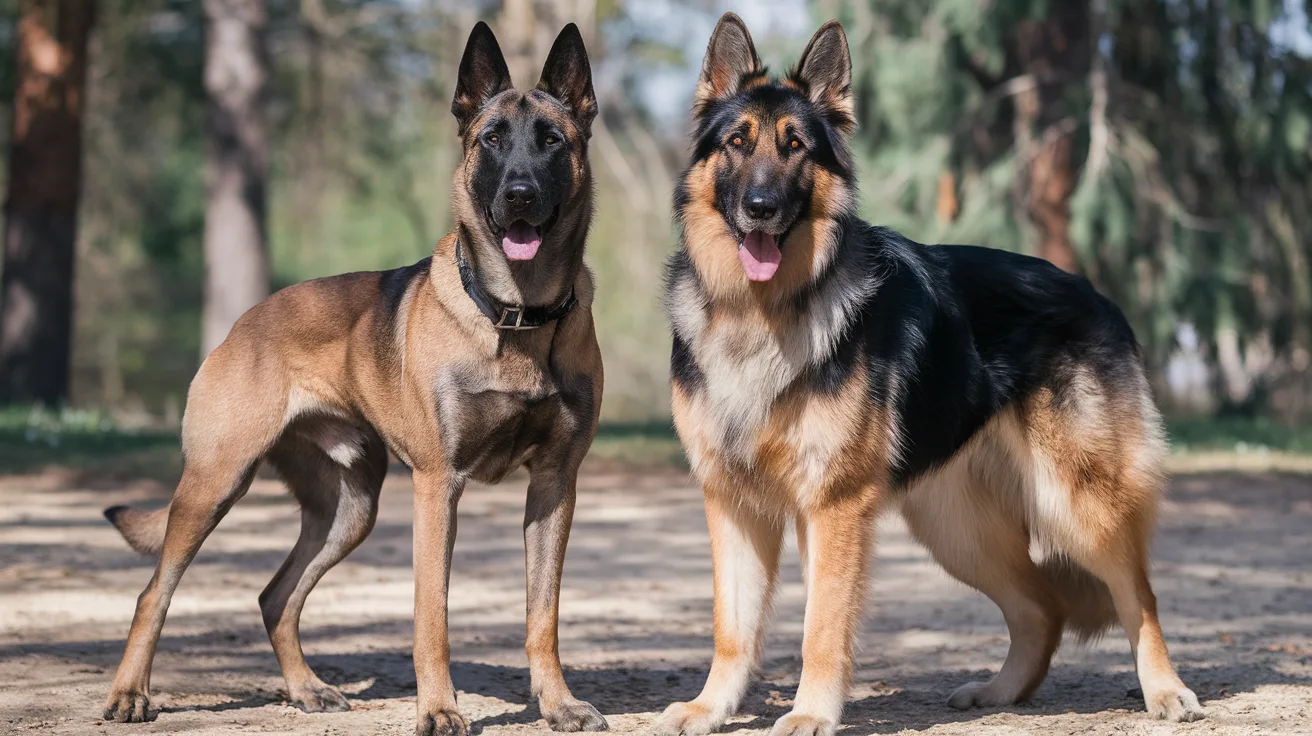You’ve spent hours comparing Belgian Malinois Dog vs German Shepherd videos online, and you’re still stuck. Which one is actually right for your lifestyle?
I get it. These two breeds look similar enough to confuse casual observers, but pick wrong and you might end up with 80 pounds of energy you weren’t prepared for.
By the end of this guide, you’ll understand exactly how Belgian Malinois dogs differ from German Shepherds in temperament, training needs, and family compatibility, especially in the context of the Belgian Malinois Dog vs German Shepherd comparison.
The truth? Most people who think they want a Malinois should probably get a German Shepherd. But there’s a specific type of owner who’d regret that advice completely.

Quick Navigation
Breed Origins and History
Belgian Malinois: The Working Heritage
The Belgian Malinois emerged in the late 1800s near Malines, Belgium, where shepherds needed efficient herding dogs with boundless energy. These copper-coated dynamos quickly gained fame for their work ethic, serving as police dogs, border patrol, and military K9s worldwide. You can learn more about the official breed standard and characteristics from The Kennel Club’s Belgian Malinois profile.
German Shepherd: From Herding to Multi-Purpose
German Shepherds hit the scene in 1899 when Captain Max von Stephanitz spotted a wolf-like dog at a show and thought, “That’s the perfect working dog.” He established the breed standard focusing on intelligence and versatility. The breed exploded in popularity after WWI, becoming America’s favourite police and service dog. For an official overview of the breed, see The Kennel Club’s German Shepherd dog page.
Comparison Table

Physical Characteristics Comparison
A. Size, Weight, and Build Differences
German Shepherds are beefier, standing 22-26 inches tall and weighing 50-90 pounds. Their broader chest and substantial bone structure make them look more imposing. Belgian Malinois are leaner athletes, typically 22-26 inches tall but lighter at 40-80 pounds, with a more rectangular body shape and less bulky frame.
B. Coat Types and Maintenance Requirements
German Shepherds rock a double coat that’s medium to long, shedding year-round with massive seasonal “blow-outs.” Get ready to vacuum daily! Malinois have shorter, harder coats that shed less and only need weekly brushing. For busy folks or clean freaks, the Mal’s easier grooming routine is a major win. Regular use of one of the best dog brushes for German Shepherds helps control shedding and maintain their coat’s health. For owners who prefer home grooming, investing in one of the best dog clippers for thick or double coats can make maintaining a Malinois or German Shepherd’s coat more manageable.
C. Distinctive Features and Appearance
The Malinois sports a fawn to mahogany coat with a black mask and ears that scream alertness. Their eyes hold that intense “ready to work” gaze. German Shepherds come in more colours (black and tan being classic) with their signature sloped back and confident stance. The GSD has a more wolf-like appearance, while the Mal looks like a lightweight athlete.
D. Lifespan and Health Considerations
German Shepherds typically live 9-13 years but are prone to hip dysplasia, degenerative myelopathy, and bloat. The Belgian Malinois edges them out with a 12-14 year lifespan and fewer breed-specific health issues. Both breeds need hip evaluations, but the Malinois generally enjoys better overall health due to less extreme breeding for appearance. For dogs prone to joint issues like hip dysplasia, consider exploring the best dog joint supplements to support mobility and long-term health.

Temperament and Personality Traits
A. Belgian Malinois: The High-Drive Workaholic
Ever watched a Malinois in action? These dogs simply don’t have an “off” switch. They wake up ready to work, play, train, repeat. Mals bring intensity to everything they do – from fetching a ball to protecting their family. Not just active, they’re hyperactive with a mind that needs constant stimulation.
B. German Shepherd: The Confident Guardian
German Shepherds carry themselves with a natural dignity that’s hard to miss. They size up situations before reacting, unlike the more impulsive Malinois. These dogs possess remarkable emotional intelligence, often seeming to understand exactly what their humans need. Their confidence isn’t arrogance – it’s earned through their natural ability to handle complex tasks.
Training and Intelligence
Belgian Malinois’ Learning Style and Capabilities
Malinois dogs pick up commands like lightning. Give them a task once or twice, and they’ve got it down. Their intense focus and eagerness to please make them ideal for complex work, such as military operations and search-and-rescue missions, where split-second decisions matter.
German Shepherd’s Problem-Solving Abilities
German Shepherds think differently. They analyse situations before acting, making them exceptional problem-solvers. Watch a Shepherd figure out how to open a gate or navigate an obstacle course – they’re methodically thinking through each step. This deliberate approach makes them stars in police work and as service dogs.
Working Roles and Capabilities
Belgian Malinois in Police and Military Service
Malinois dogs are absolute rockstars in police and military work. Their lightning-fast reflexes and crazy-high drive make them perfect for tracking down bad guys and detecting explosives. They’re smaller than German Shepherds but pack just as much power with less weight to carry around, which means they can jump higher and run longer without getting tired.
German Shepherd’s Versatility in Service Work
German Shepherds bring a balanced approach to service work that’s hard to beat. These dogs aren’t just one-trick ponies – they excel at everything from police work to guide dog duties. Their slightly calmer temperament compared to the Malinois means they can switch gears between intense protection work and gentler assistance tasks with ease.
The German Shepherd was developed in Germany in the late 19th century by Captain Max von Stephanitz. His goal was to create an intelligent and versatile working dog. The breed became famous for its roles in police, military, and search-and-rescue operations, quickly gaining international recognition.
Both dogs share a similar working background, but when comparing Belgian Malinois vs German Shepherd, the Malinois has a more specialised focus on agility and quick responses, while the German Shepherd is known for its versatility in many different tasks.
Exercise and Stimulation Requirements
A. Daily Exercise Needs for Belgian Malinois
Belgian Malinois dogs are energy powerhouses that need serious workout time – we’re talking 2+ hours daily of intense activity. Not just casual walks around the block either. These dogs thrive on running, agility training, and jobs that challenge both body and mind. Skip their exercise and watch your furniture become their next victim.
B. Keeping a German Shepherd Physically Satisfied
German Shepherds need about 1-2 hours of daily exercise, slightly less demanding than their Malinois cousins. They love structured activities like fetch, hiking, and swimming. The difference? GSDs can actually chill out after their exercise, while Malinois might still be bouncing off walls. Both breeds need consistency – miss a few days and you’ll definitely notice the difference.
C. Mental Stimulation Differences
Malinois have working brains that never quit. They need constant mental challenges – puzzle toys, scent work, and training sessions that make them think. Give them problems to solve or they’ll create their own (usually destructive ones). Malinois thrive with interactive challenges. You can check out some essential dog enrichment toys that can provide vital enrichment and reduce destructive behaviours.
D. Consequences of Insufficient Activity for Each Breed
Underexercised Malinois become destruction machines – chewed furniture, dug-up yards, and anxiety behaviours like excessive barking. German Shepherds handle boredom slightly better but still develop issues like weight gain, depression, and unwanted behaviours. Both breeds can become difficult to handle when their exercise needs aren’t met.
When it comes to choosing a dog, understanding their temperament is essential. Both the Belgian Malinois and the German Shepherd are known for their intelligence and loyalty, but they do have some differences that can make one a better fit depending on your lifestyle.
Living With Each Breed
A. Space Requirements and Housing Considerations
Belgian Malinois need room to zoom. These high-energy dogs get stir-crazy in apartments and thrive in homes with fenced yards where they can burn off steam. They’re not great candidates for apartment living unless you’re committed to multiple daily exercise sessions.
German Shepherds are more adaptable. While they certainly benefit from space, they can adjust to apartment living if given proper exercise. They’re less likely to bounce off the walls compared to Malinois, but still need daily activity to prevent destructive behaviour from boredom.
Knowing your space requirements is key when deciding on a German Shepherd or Belgian Malinois.
B. Cost of Ownership Comparison
Owning either breed isn’t cheap, but there are differences. German Shepherds typically cost $500-$1,500 initially, while Malinois range from $1,000-$2,500 from reputable breeders. Annual costs run about $1,200-$1,800 for both breeds, covering food, vet care, and basic supplies.
The hidden expenses come from their energy needs. Malinois often require more specialised training ($1,000+) and enrichment toys to stay mentally satisfied. Both breeds are prone to hip issues, but German Shepherds generally have higher lifetime medical costs due to more health concerns. To keep your German Shepherd in peak condition, it’s worth choosing from the best large breed dog food tailored for breeds like the German Shepherd and Belgian Malinois.
C. Time Commitment Realities
Nobody’s sugar-coating this – both breeds demand serious time investment. Malinois owners need to commit 2-3 hours daily for exercise, training, and mental stimulation. These dogs don’t have an “off” switch and will find their own entertainment (usually destructive) if bored.
German Shepherds require 1-2 hours of daily activity and engagement. They’re slightly more content to relax at home after proper exercise. Both breeds need consistent training throughout their lives, not just puppyhood, but Malinois particularly need ongoing challenges to stay balanced.
D. Ideal Owner Profiles for Each Breed
The perfect Malinois owner? Active, experienced, and committed. Think runners, hikers, or dog sport enthusiasts with previous dog ownership experience. First-time owners usually struggle with their intensity. They shine with owners who provide clear structure and plenty of meaningful work.
German Shepherds match well with active families, including first-time owners willing to learn and train consistently. They adapt better to family life with children and appreciate having a job, whether it’s formal work or being the family protector. They’re versatile companions for various lifestyles.
E. Managing Breed-Specific Challenges
Malinois owners often struggle to manage their dog’s intense drive and energy. Success means channelling these traits positively through consistent training, work, and exercise. Without proper outlets, anxiety, destructiveness, and reactivity become real problems.
German Shepherd challenges centre around managing shedding (it’s constant and impressive), potential health issues, and their protective nature. Early socialisation prevents overprotectiveness, while regular brushing helps control the fur tumbleweeds. Their natural wariness requires attention to prevent suspicion of all strangers.

Conclusion
Both the Belgian Malinois and German Shepherd stand as exceptional working dogs, each with their own unique strengths and characteristics. While German Shepherds offer a more versatile companion with their balanced temperament and adaptability to family life, Belgian Malinois excel in high-intensity working environments with their remarkable drive and agility. Physical differences between these breeds are subtle but important, with the Malinois typically being lighter and more agile, while Shepherds present a more substantial, powerful build.
When choosing between these magnificent breeds, consider your lifestyle honestly. Both require significant exercise, mental stimulation, and consistent training, but the Malinois typically demands even more engagement and activity. Whether you select the intense, focused Malinois or the versatile, loyal German Shepherd, commitment to proper training and socialisation will reward you with an extraordinary canine partner that exemplifies the best qualities working dogs have to offer.
Frequently Asked Questions
What are the main differences between a German Shepherd and a Belgian Malinois?
German Shepherds are generally larger, with a heavier build and a more pronounced physical appearance. They typically have a longer coat, which can be either medium or long in length. Belgian Malinois are usually smaller, more agile, and have a short, sleek coat. German Shepherds are often known for their versatility in various roles, including police and service work, while Belgian Malinois are favoured for their high energy and strong drive, making them excel in protection work and agility tasks. Temperament-wise, German Shepherds are often more laid-back, whereas Belgian Malinois tend to be more active and require more stimulation.
How can you tell a Belgian Malinois from a German Shepherd?
The Belgian Malinois is generally smaller and more agile than the German Shepherd, with a shorter, fawn or mahogany coat and a black mask. German Shepherds are larger, have a more robust build, and feature a longer coat that can be black and tan, sable, or all black. The ears of a Belgian Malinois are typically more pointed and erect, while German Shepherds have a more varied ear shape. Additionally, Belgian Malinois often exhibit a more energetic and playful temperament.
Is a Belgian Malinois easier to train than a German Shepherd?
Yes, a Belgian Malinois is generally considered easier to train than a German Shepherd.

